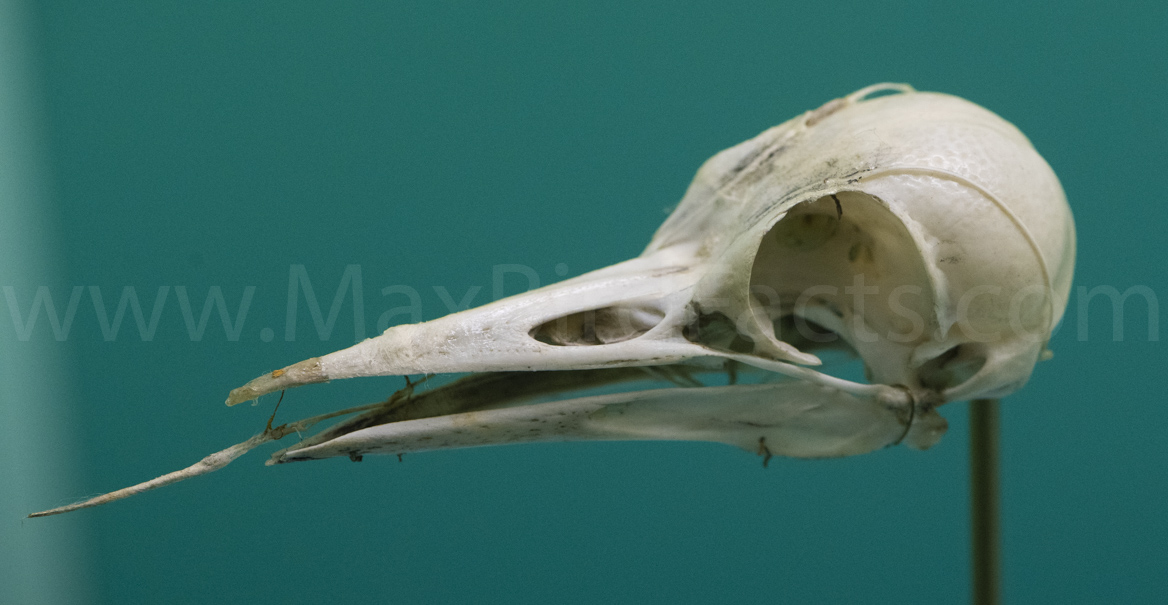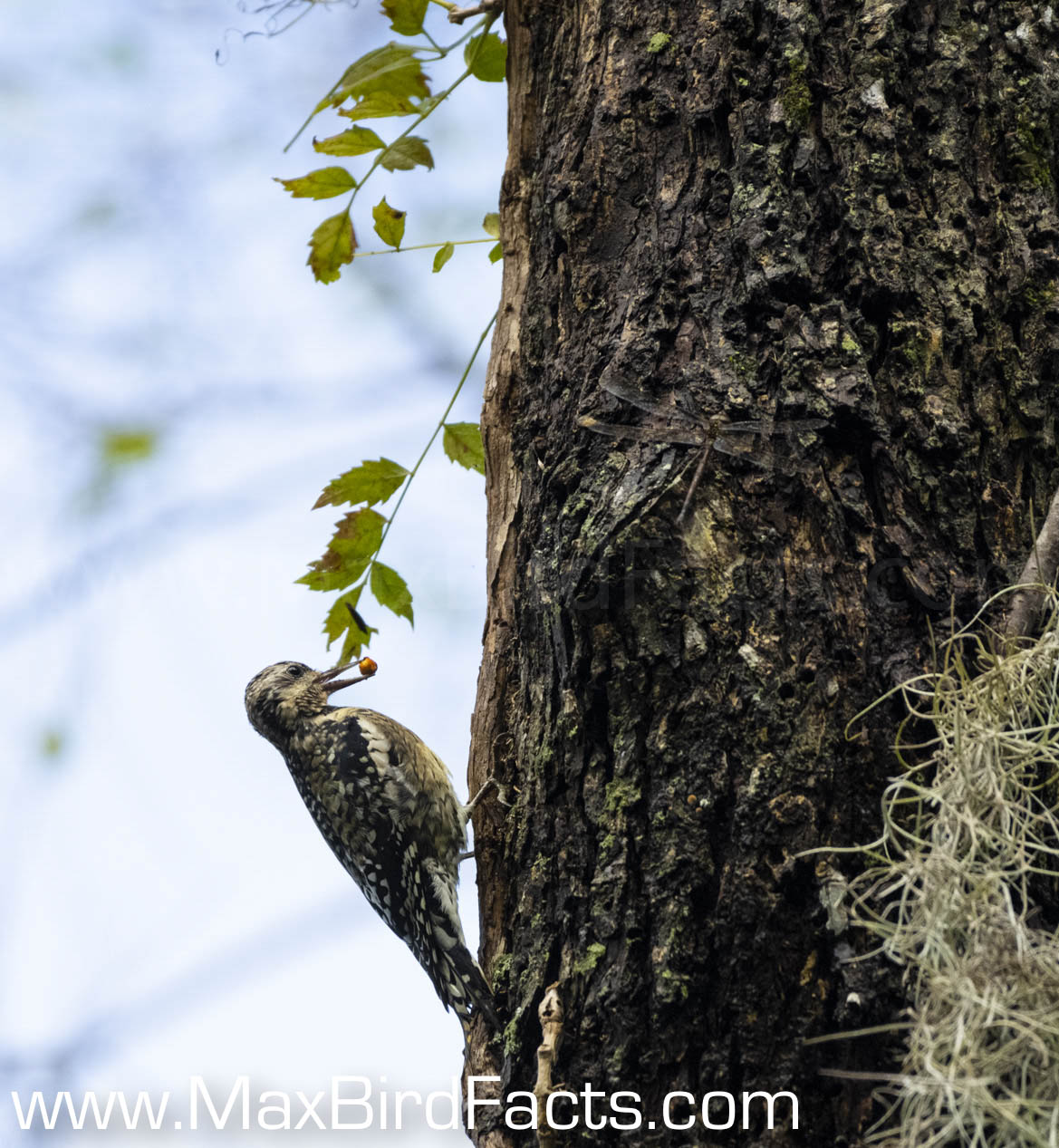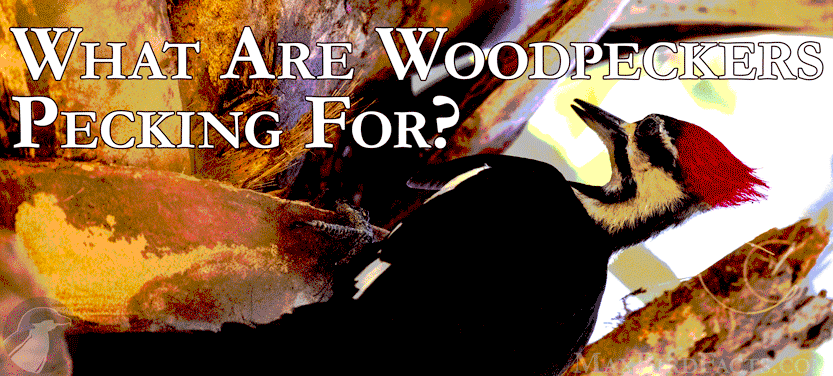Woodpeckers peck for three primary reasons: foraging, nesting, and signaling.
The pecking action is impressive and not seen to the same extent in any other group of birds. This exceptional action requires particular adaptations to these birds’ bodies.
Let’s dive right into the reasons why woodpeckers peck, starting with food.
Drilling For Bugs
Finding an available niche has been the driving motive for the evolution of new species since life has existed on earth.
Hundreds of bird species cling to sheer surfaces and probe for insects and tiny morsels amid the cracks and crevices of rock and bark. However, I don’t think any are as remarkable as our woodpeckers.
Woodpeckers didn’t earn their names by random. Their unusual behavior was officially honored in 1820 when William Elford Leach formed the family Picidae. Researching this, I found out the Latin meaning of Pici or Picus has always meant “woodpecker.”

The most regular use of pecking for this clade is finding, and sometimes storing, food. So why chisel away at bark?
As I mentioned earlier, drilling into trees for food isn’t normal for many birds, which means it’s an unoccupied niche. This availability of unopposed resources gave the ancestors of modern woodpeckers the push they needed.
However, drilling through wood can be a tedious ordeal, and without special equipment, it can lead to life-threatening injury. Luckily for our woodpeckers, they are packed with unique and unusual features.
A woodpecker’s feet have a toe arrangement called zygodactyl. This is where the toes form an x-shape, giving the bird tremendous grip strength.
Woodpeckers pair their vice-like feet with stiff tail feathers to steady themselves against a tree trunk.
Their most impressive adaptations are in the head and skull. Thick, spongy bone absorbs the shock and impact of pecking. This spongy bone, along with a very specialized beak shape and hyoid bone, woodpeckers can hammer away at trees all day without any injury.
Their tongue is just as fascinating. A woodpecker’s tongue completely wraps around its skull, and it’s long enough to reach deep into the trees. With many woodpecker species, the tongue is barbed at the end, ensuring they capture their prey once located.

Millions of years of evolution through random mutation and natural selection led to the perfectly designed features woodpeckers today use to drill into even the hardest woods.
The primary purpose of this drive, I believe, would be the accessibility of food. If you go into your back yard or local park right now, there are warblers on the ground, swifts buzzing in the air, hawks screaming from branches, and herons spearing fish.
These birds have followed their own evolutionary paths to be the best in their respective niches, just like woodpeckers. Instead of competing with ground-foraging, hawking, spearing, or raptorial feeding behaviors, woodpeckers have found an untapped source of food.
Many insect species will bore into wood to be safe while maturing into their adult forms. As these invertebrates grow, they chew their way through the tree to gain nutrients.
These burrows create hollow channels in the tree, which leads the woodpeckers right to the grub.
When a woodpecker hunts, it won’t drill at one location mindlessly, hoping for a meal. Instead, it taps on the wood, looking for the hollow reverberation of the grub’s path.
If you watch a woodpecker up in a tree and see it rip off a patch of bark, make a few taps, and clamber onto another section of wood, it’s on the hunt for some lunch.
After locating the prey, the woodpecker will anchor itself into the wood by digging in those x-shaped talons, pressing its stiff tail into the bark for support, and begin hammering away. It won’t take long before the bird has breached the channel, and then it can use its long, barbed tongue for fishing out the meal.

Woodpeckers don’t just eat bugs, though. They are also notoriously fond of acorns and other tree nuts.
Acorn Woodpeckers will find a dead tree, riddle it with holes, and wedge acorns into them. These trees are called granary trees, and they might store tens of thousands of acorns.
Nuts are a great source of fat, another vital dietary requirement for birds. In addition, fat is the most fuel-efficient energy food source available to any animal.
These granary trees can help non-migratory woodpeckers, like the Acorn Woodpecker, through winters that other birds have to avoid through migration.
Living IN The Trees
The ability to drill into wood doesn’t stop with finding food. Woodpeckers use their spectacular beaks to excavate massive amounts of material to create their nests.

Woodpeckers are primary excavators and primary cavity nesters. This role is crucial to many other cavity nesters that cannot drill these hollows into the dense wood.
This seems like a lot of extra effort compared to forming a traditional nest, but in the long run, woodpeckers win. Think of all the time, energy, and effort a bird needs to give when finding the perfect stick to continue the construction of its nest.
Conversely, the woodpecker needs to drill out a big enough hold for itself, their mate, and the eggs that will be laid. Then, if the cavity becomes too cramped, the bird can whittle away at the walls.

This nest is also much safer from the elements. The only exposed area of the nest is the entrance, which is typically placed so that rain won’t enter.
The nest can also last much longer. These hollows will remain in the tree, pretty much until it falls to the ground.
Unfortunately, secondary cavity nesters will hurridly move in when the woodpecker family fledges.
Eastern Bluebirds, Wood Ducks, Eastern Screech-Owls, Tree Swallows, and even the occasional squirrel are happy to steal a woodpecker’s old hollow.

Drumming On Trees
The third, and my favorite reason for what woodpeckers are pecking for, is communication.
If you’ve walked in dense, swampy forests, you’ve probably heard the distant drumming of a Pileated or Red-bellied Woodpecker. However, each species of woodpecker has its own distinct resonance.
For instance, the Pileated Woodpecker’s deep, powerful drum reflects its size and stature. Compare this to the tiny Downy Woodpecker’s much more hurried and higher-pitched drum.
The bird’s size could easily explain these auditory differences. Smaller woodpeckers seem to produce higher-pitched drums with a much faster cadence. Conversely, larger woodpeckers tend to have heavy drums that last much longer.

Distinguishing one species from another based solely on its drum is a difficult feat. However, the drum perfectly gives away the woodpecker’s location to be spotted through my camera or binoculars.
Drumming isn’t their only form of communication. Woodpeckers do vocalize, even if it isn’t as refined songs as you can hear from the Passerines (Songbirds) that visit your feeders.
When woodpeckers sing, they produce some unbelievable sounds. Shrieks, barks, coughs, thrills, chatters, grumbles, peeks, piks, pits, and whinnies are just a few of the sounds these birds make.
Along with these calls and songs, drums carry auditory messages far through impenetrable woods. The low-frequency vibrations these drums produce cut through the dense forests and move farther than a simple call or song could.

Male woodpeckers regularly use drumming to warn other males to stay out of their territory. Maintaining territory is a vital task for any bird, which holds true with woodpeckers.
Many birds in Central Florida are annual residents, meaning they never migrate during breeding and non-breeding seasons. The Pileated, Red-bellied, and Downy Woodpeckers are three main species that can be seen year-round throughout the Sunshine State.
Each of these birds requires a territory, and it has to be maintained because they never leave the state.

Suppose a migratory Yellow-bellied Sapsucker wanders into a Red-bellied Woodpecker’s territory. In that case, this isn’t ideal but not a huge threat. The Yellow-bellied Sapsucker will leave again during the spring migration, heading north to its breeding grounds.
However, if another Red-bellied Woodpecker shows up, this could pose a severe threat. The rival male might try to overthrow the current tenant and force him to flee.
Drumming can help prevent this. The male’s drums send a signal that will also reflect his current physical status.
If the rapping on the wood is at a consistent and rhythmic tempo, the bird is in good health. Along with this, the sound needs to be clear and resonate through the tree for it to carry accurately.
The drums will be enough to deter rivals from showing up and possibly even attract a female if all goes well.
Now We Know What Are Woodpeckers Pecking For
The three main reasons woodpeckers peck is food, shelter, and communication.
The unfilled niche of wood-boring insects created just enough pressure for the ancestors of modern woodpeckers to follow the path they’ve ended up at today.
With the ability to chip away wood, these fascinating birds also dig into the trees to build their homes.
Adaptations to their skull, feet, and tail have made these birds into the perfect flying-power-drills.
Thank you for reading through this article. I really hope you learned something new from it!
If you have any suggestions for future articles or topics you would like me to cover, please leave a comment or shoot me an email.
Make today great!
Max

Discover more from Welcome to MaxBirdFacts.com!!!
Subscribe to get the latest posts sent to your email.
